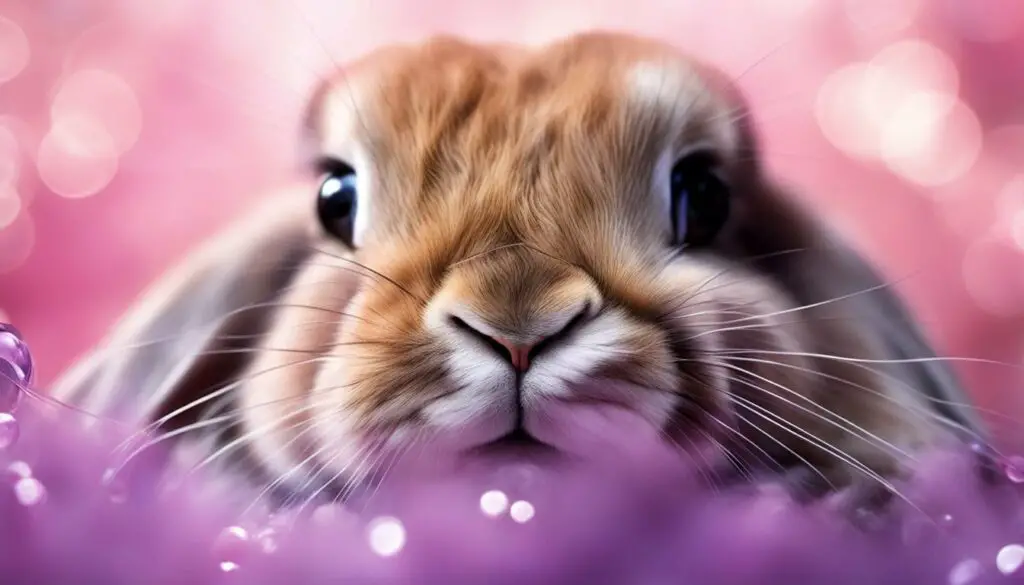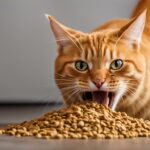Rabbits have a complex system of communication that involves both vocalizations and body language. While they are generally known to be quiet animals, rabbits do make noises, including purring. Understanding the different sounds rabbits make and what they mean can help you better understand and bond with your pet bunny.
Key Takeaways:
- Rabbits have a wide range of sounds they use to communicate, including honking, humming, tooth purring, teeth grinding, growling, grunting, whimpering, and hissing.
- Each sound has its own meaning, ranging from happiness and contentment to pain and fear.
- Purring, through tooth chattering or other sounds, is a sign of contentment in rabbits.
- Teeth chattering can also indicate pain, discomfort, or distress, so it’s important to be alert to any changes in context.
- Providing a calm and supportive environment can help rabbits cope with stress and anxiety.
The Range of Rabbit Sounds and Their Meanings
Rabbits have a wide range of sounds they use to communicate, each with its own unique meaning. By understanding these vocalizations, you can gain valuable insights into your rabbit’s emotional state and needs. Here are some of the different sounds rabbits make and what they signify:
Honking
Honking or oinking is a loud and abrupt sound that indicates excitement or happiness. It can often be heard when rabbits are playing or experiencing something enjoyable. It’s a positive sign that your rabbit is feeling content and having fun.
Humming
Humming is a softer noise that signifies contentment. It’s a gentle and rhythmic sound that rabbits make when they are feeling relaxed and at ease. You may hear your rabbit humming when they are resting or being petted.
Teeth Purring
Teeth purring is a unique sound that rabbits make by gently rubbing their teeth together. It is a sign of happiness and relaxation. When your rabbit purrs, it means they are feeling safe and comfortable in their environment. It’s a positive sound that shows they trust you and enjoy your company.
Growling
Growling is a deep, guttural sound that rabbits produce to express fear or aggression. It is a warning sign that your rabbit is feeling threatened or uncomfortable. If you hear your rabbit growling, it’s important to give them space and reassess the situation to avoid any potential conflicts or stress.
By listening and observing these sounds, along with your rabbit’s body language, you can better understand their needs and provide them with the care and attention they require to thrive.

| Sound | Meaning |
|---|---|
| Honking | Excitement or happiness |
| Humming | Contentment |
| Teeth Purring | Happiness and relaxation |
| Growling | Fear or aggression |
Understanding Rabbit Honking, Humming, and Tooth Purring
Rabbits have unique ways of expressing themselves through sounds. Honking, humming, and tooth purring are some of the distinctive sounds that rabbits make. These sounds carry different meanings and provide valuable insights into a rabbit’s emotional state and needs.
Rabbit Honking: Honking is a loud and abrupt sound that rabbits produce when they are excited or happy. It can be compared to the honk of a goose and is often accompanied by playful behavior such as zooming around or binkying. When a rabbit honks, it indicates a positive and joyous state of mind.
Rabbit Humming: Humming is a softer noise that rabbits make when they are content and relaxed. It is a gentle and soothing sound that signifies happiness and comfort. When a rabbit hums, it shows that they are at peace and enjoying their surroundings.
Tooth Purring in Rabbits: Tooth purring is a unique behavior in rabbits where they gently rub their teeth together. This expression of happiness and relaxation is different from a cat’s purring. When a rabbit tooth purrs, it indicates a sense of contentment and satisfaction.
Understanding these sounds, along with observing accompanying body language, can help rabbit owners provide appropriate care and attention. It enables them to decipher their rabbit’s emotional well-being and strengthen their bond. By creating a safe and nurturing environment, rabbit owners can ensure their pet’s happiness and overall well-being.
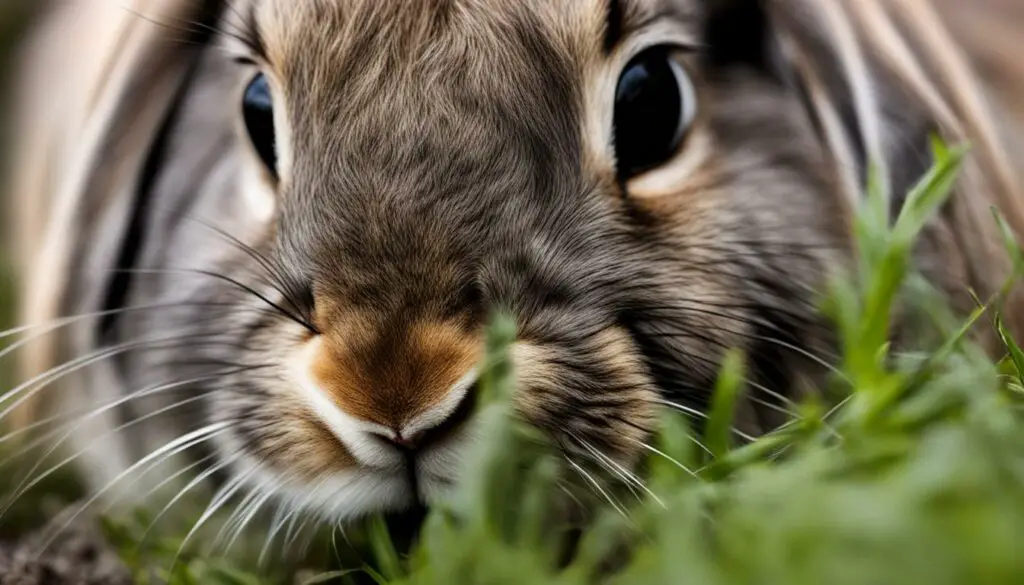
Rabbit Sounds and Their Meanings
| Rabbit Sound | Meaning |
|---|---|
| Honking | Excitement or happiness |
| Humming | Contentment and relaxation |
| Tooth Purring | Happiness and relaxation |
Exploring Rabbit Teeth Grinding and Growling
In addition to purring, rabbits also communicate through teeth grinding and growling. These sounds can indicate pain, discomfort, or a feeling of threat. Teeth grinding, also known as teeth chattering, is a repetitive grinding of the teeth and may be a sign of dental issues or general pain. Growling is a deep, guttural sound that rabbits produce to express fear or aggression.
It is crucial for rabbit owners to identify the cause of these sounds and address any underlying health or environmental factors that may be contributing to their rabbit’s discomfort. If you notice your rabbit grinding their teeth or growling frequently, it is essential to consult a veterinarian to ensure their well-being.
Teeth Grinding in Rabbits
Teeth grinding in rabbits, also referred to as bruxism, can occur for various reasons. It can be a result of dental problems, such as overgrown teeth or misaligned jaws, which can cause pain and difficulty eating. In some cases, rabbits may also grind their teeth as a response to general discomfort, stress, or anxiety.
Addressing dental issues is crucial to alleviate any pain or discomfort associated with teeth grinding. Regular dental check-ups and proper rabbit-friendly diet, including hay and chew toys, can help maintain the health of their teeth and reduce the likelihood of grinding. Additionally, providing a calm and stress-free environment for your rabbit can help minimize teeth grinding caused by anxiety or discomfort.
Growling in Rabbits
Growling is a sound that rabbits produce when they feel threatened or scared. It is a warning sign indicating that the rabbit is not comfortable and may exhibit aggressive behavior if the situation escalates. Growling can be accompanied by other defensive behaviors, such as lunging, biting, or thumping their hind legs.
If your rabbit is growling, it is essential to give them space and avoid any actions or interactions that may further agitate them. Creating a safe and secure environment for your rabbit can help reduce the likelihood of growling and promote their overall well-being. This includes providing hiding spots, minimizing loud noises, and ensuring a calm and predictable routine.
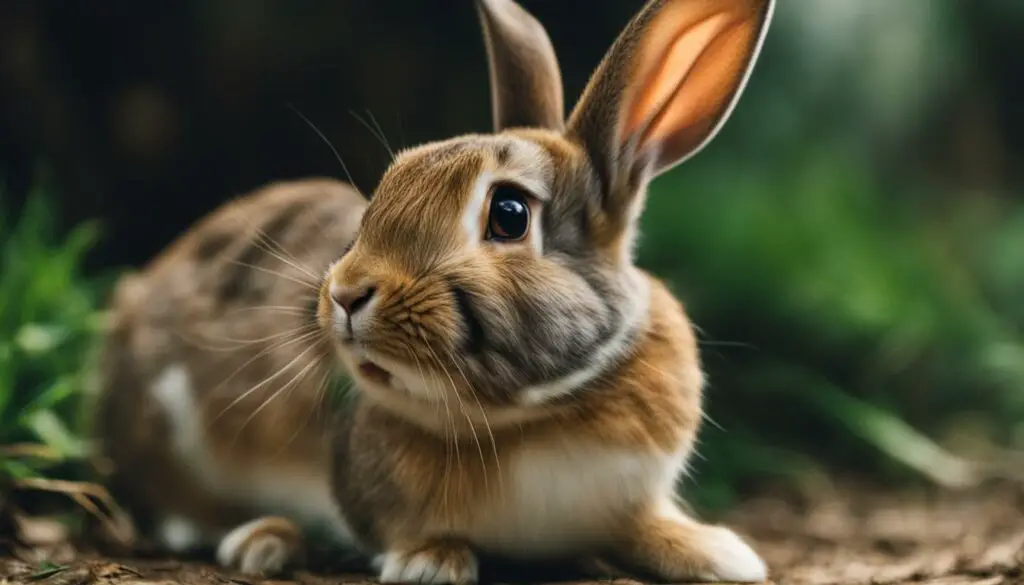
Summary:
Rabbits communicate through a variety of sounds, including teeth grinding and growling. Teeth grinding can be a sign of dental issues or general discomfort, while growling indicates fear or aggression. It is essential for rabbit owners to identify the cause of these sounds and address any underlying health or environmental factors that may be contributing to their rabbit’s discomfort. Maintaining regular veterinary check-ups, providing a rabbit-friendly diet and environment, and recognizing the signs of stress or anxiety can help ensure the well-being of pet bunnies.
Understanding Rabbit Grunting and Whimpering
Rabbits have a unique way of expressing themselves through various sounds, including grunting and whimpering. These vocalizations can provide valuable insights into your rabbit’s emotional state and needs. Understanding the meaning behind these sounds will help you better care for and communicate with your furry friend.
What is Rabbit Grunting?
Rabbit grunting is a low, short sound that rabbits make to express mild annoyance, discomfort, or uncertainty. It can occur in situations where a rabbit feels threatened, picked up abruptly, or finds themselves in an uncomfortable environment. It’s important to pay attention to the context in which grunting occurs to identify any potential triggers and address them accordingly.
What Does Rabbit Whimpering Mean?
Rabbit whimpering is a heartbreaking cry that indicates pain, stress, or a need for attention. Whimpering can occur when a rabbit is experiencing physical discomfort or emotional distress. It’s crucial to act promptly when you hear your rabbit whimper by providing comfort, checking for any signs of injury or illness, and consulting a veterinarian if necessary.
| Rabbit Grunting | Rabbit Whimpering |
|---|---|
| Low, short sound | Heartbreaking cry |
| Mild annoyance, discomfort, or uncertainty | Pain, stress, or need for attention |
| Context-dependent | Indicates physical or emotional distress |
Both grunting and whimpering are forms of communication that rabbits use to express their feelings. By paying attention to these sounds and their accompanying body language, you can provide the care and support your rabbit needs to live a happy and healthy life.
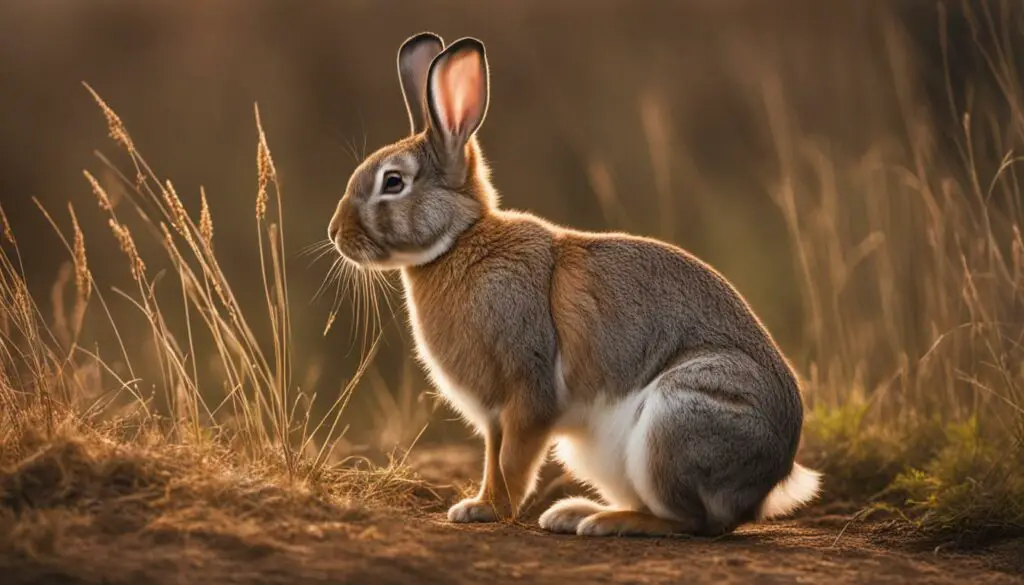
“Understanding the meaning behind these sounds will help you better care for and communicate with your furry friend.”
- Rabbit grunting is a low, short sound that expresses mild annoyance or discomfort.
- Rabbit whimpering is a heartbreaking cry that indicates pain, stress, or a need for attention.
- Both sounds provide insights into your rabbit’s emotional state and should be addressed accordingly.
Decoding Rabbit Hissing and Its Meanings
Rabbits hiss as a defensive response when they feel threatened, irritated, or overstimulated. It is a vocalization that communicates anger or displeasure. When a rabbit hisses, it is important to respect their boundaries and give them space. Continuing to approach or interact with a hissing rabbit can escalate their aggression and potentially lead to biting or scratching. Hissing is a natural behavior for rabbits and should be understood as a sign that they need to be left alone.
Hissing can occur in various situations, such as when a rabbit is handled too roughly, when they are scared or cornered, or when they feel territorial. It is important to remember that rabbits are prey animals and their instinctual response to threats is to defend themselves. Understanding the triggers for hissing can help you create a safe and secure environment for your rabbit, minimizing potential stressors and avoiding situations that may cause them to feel threatened.
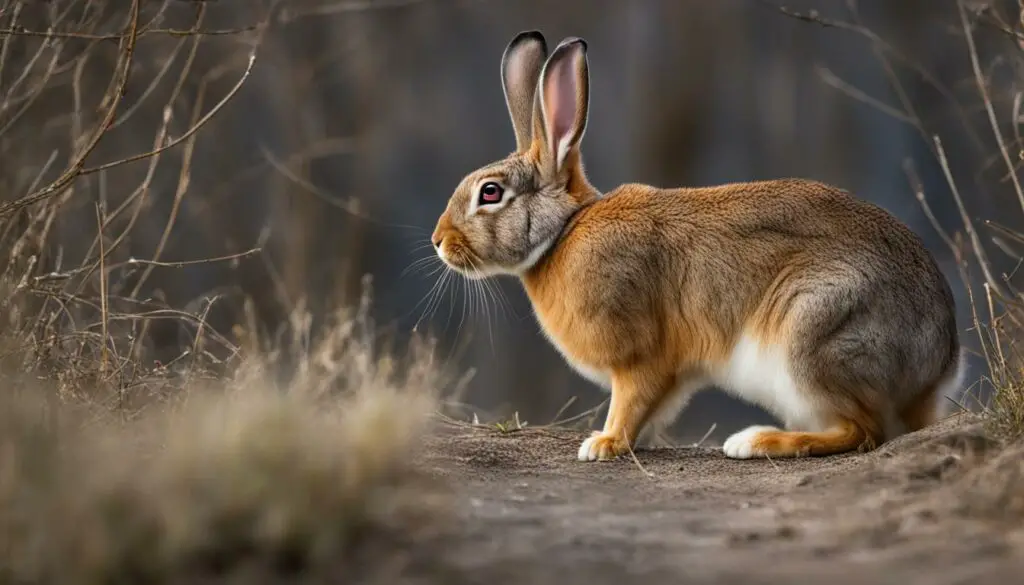
“I learned that when my rabbit hisses, it means she is feeling angry or annoyed. It’s important for me to give her some space and allow her to calm down. Rabbits are sensitive animals, and it is crucial to respect their boundaries and make them feel safe and secure.” – Rabbit owner
Tips for Dealing with a Hissing Rabbit
- Remain calm and avoid sudden movements when near a hissing rabbit.
- Do not attempt to pick up or handle a hissing rabbit.
- Give the rabbit some time and space to calm down.
- Observe the rabbit’s body language for signs of fear or aggression.
- Ensure that the rabbit’s living environment is quiet and stress-free.
- Consult with a rabbit-savvy veterinarian or animal behaviorist if the hissing behavior persists or becomes more frequent.
Hissing is a part of the communication repertoire of rabbits, and while it may be alarming or unsettling, it is essential to understand its meaning and respond in a way that promotes the well-being of your rabbit. By providing a safe and comfortable environment and respecting their boundaries, you can help your rabbit feel secure and reduce the likelihood of hissing incidents.
When Rabbits Click Their Teeth While Sleeping
Did you know that some rabbits click their teeth together or make chattering sounds while they sleep? It may seem strange, but this behavior is actually quite common and usually nothing to worry about. When rabbits sleep, they often enter a state of light doze where their muscles twitch and contract, including their jaw muscles. This can cause their teeth to click together, resulting in the chattering sound.
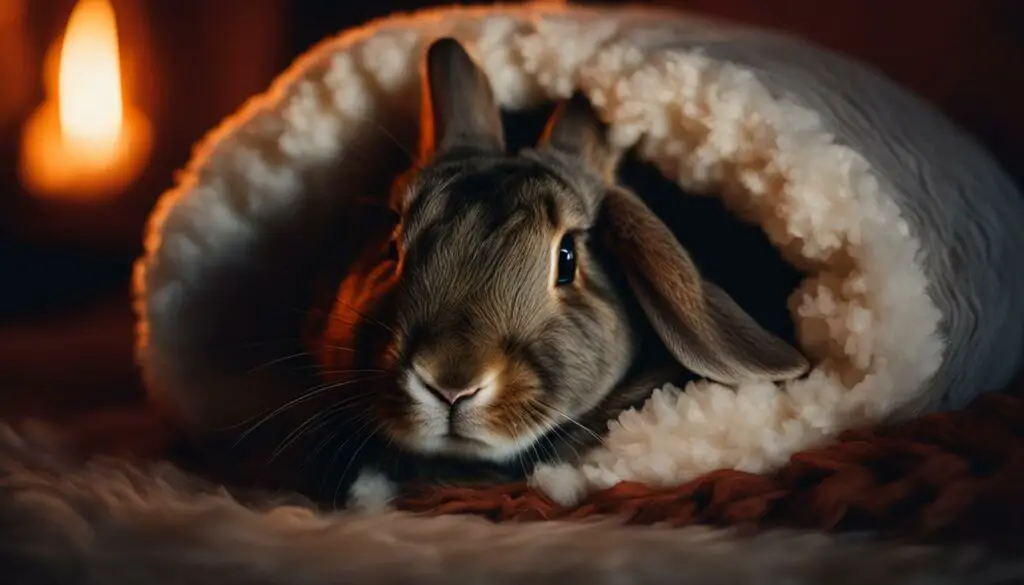
This teeth chattering during sleep is typically harmless and does not indicate any discomfort or pain. It is simply a natural part of a rabbit’s sleep cycle. So, if you notice your rabbit making these clicking or chattering sounds while they are sleeping, there is no cause for concern.
However, it’s important to note that teeth chattering or grinding during other times, especially when accompanied by behavioral changes or signs of pain, may indicate underlying health issues and should be evaluated by a veterinarian.
Table: Rabbit Teeth Chattering While Sleeping
| Behavior | Meaning |
|---|---|
| Teeth chattering during sleep | Normal muscle contractions during light doze |
| Teeth chattering at other times | Possible sign of pain or discomfort, requires veterinary attention |
Understanding your rabbit’s behavior and body language is essential for providing the best care and ensuring their well-being. By recognizing that teeth chattering while sleeping is a natural occurrence, you can alleviate any unnecessary concern and enjoy the delightful sounds of your bunny’s slumber.
Purring and Teeth Chattering: Signs of Contentment in Rabbits
When it comes to rabbits, understanding their communication is key to building a strong bond with your furry friend. One interesting aspect of rabbit communication is the sounds they make, including purring and teeth chattering. These sounds can provide valuable insights into your rabbit’s emotional state and overall contentment.
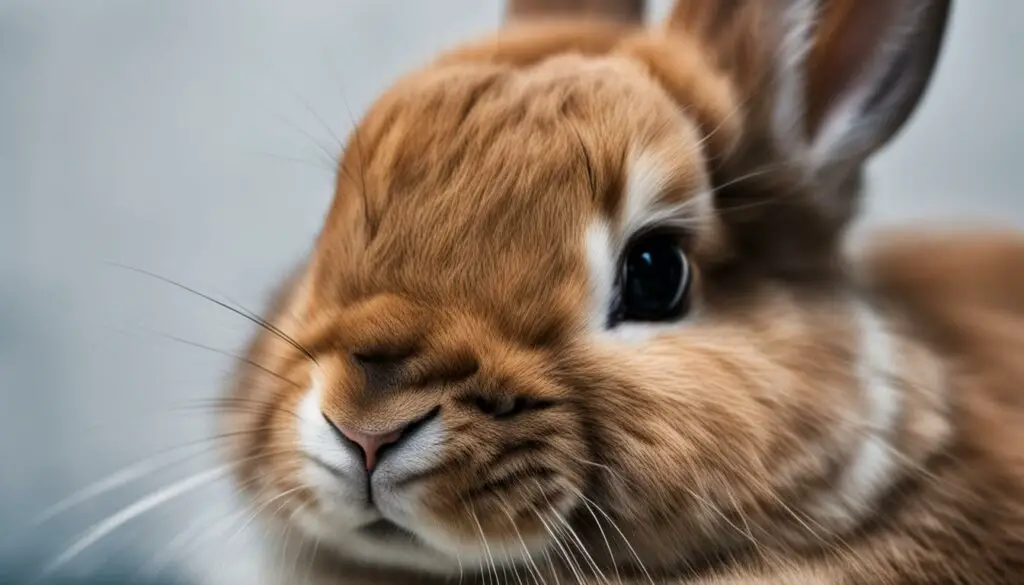
Purring is a sign of happiness and relaxation in rabbits. Just like a cat’s purr, a rabbit’s purr signifies that they feel safe, secure, and content. You may notice your rabbit purring when they are being petted, enjoying their favorite treats, or simply when they are in a relaxed state. It’s a reassuring sound that lets you know your rabbit is feeling good.
Teeth chattering, on the other hand, is another form of communication that rabbits use to express their satisfaction. While it may sound similar to teeth grinding, which can indicate pain or discomfort, teeth chattering in a happy rabbit is different. It’s a rhythmic and repetitive sound accompanied by a relaxed body posture, indicating a state of contentment and pleasure.
By recognizing these signs of contentment in your rabbit, you can create a nurturing environment that promotes their overall well-being. Spend quality time with your rabbit, provide them with a comfortable living space, and ensure their needs are met. Remember, a happy rabbit is a healthy rabbit!
Teeth Chattering as a Sign of Pain or Distress in Rabbits
Rabbits are generally known for their quiet nature, but teeth chattering can indicate a deeper issue. While teeth chattering can be a sign of contentment in rabbits, it is important to be attentive to any changes in its context, volume, or frequency. Persistent, loud chattering accompanied by other symptoms such as loss of appetite, lethargy, or unusual behavior can indicate pain or distress.
If your rabbit is exhibiting these signs, it is crucial to seek veterinary attention. A professional can help identify and address any underlying health issues that may be causing your rabbit’s discomfort. Prompt medical intervention can alleviate your rabbit’s suffering and ensure their well-being.
Therefore, it is essential to observe your rabbit closely, paying attention to any changes in their behavior or vocalization. By understanding the meaning behind teeth chattering and being proactive in seeking veterinary care, you can provide the necessary support and ensure your rabbit’s overall health and happiness. Remember, your rabbit relies on you to advocate for their well-being!
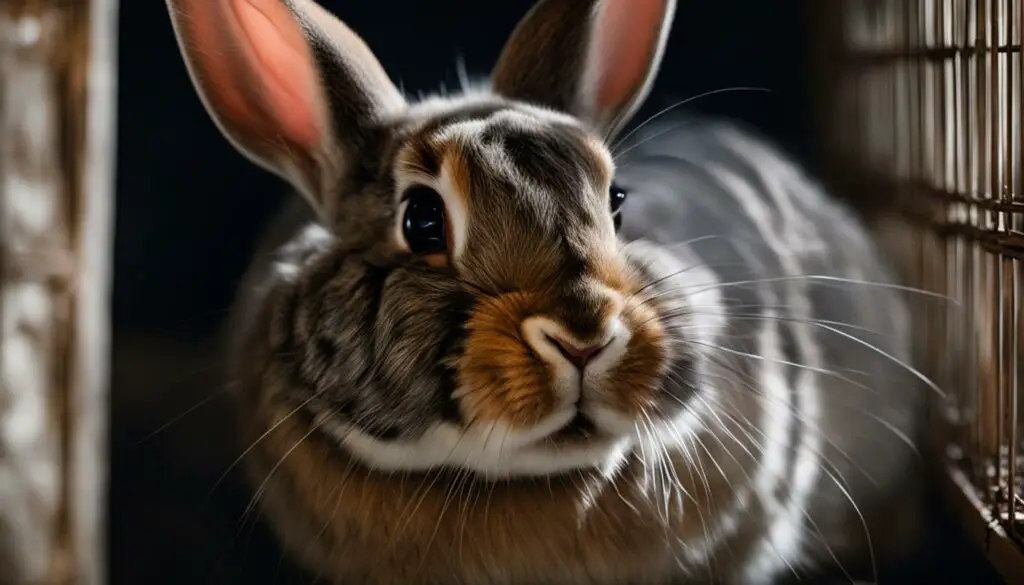
Table: Signs of Rabbit Pain and Distress
| Signs | Meaning |
|---|---|
| Loud teeth chattering | Potential pain or distress |
| Loss of appetite | Indication of discomfort or illness |
| Lethargy | Low energy levels or weakness |
| Unusual behavior | Significant deviation from normal routines |
| Visible signs of discomfort (hunched posture, reluctance to move) | Physical indications of pain or distress |
“Teeth chattering in rabbits should not be ignored, as it can be a red flag for pain or distress. It is crucial to seek veterinary attention and provide appropriate care and support to ensure your rabbit’s well-being.” – Rabbit Health Experts
Rabbit Teeth Chattering: A Sign of Stress in Rabbits
| Signs of Stressed Rabbits | Causes of Stress in Rabbits | Managing Rabbit Stress |
|---|---|---|
|
|
|
Teeth chattering in rabbits can be a sign of stress and anxiety. It is important to recognize the signs of a stressed rabbit to provide them with the necessary care and support. Some common signs of a stressed rabbit include excessive teeth chattering, decreased appetite, restlessness or aggression, and withdrawal or hiding. The causes of stress in rabbits can vary, such as changes in their environment or routine, the introduction of new pets or rabbits, and loud or unfamiliar noises.
To manage rabbit stress, it is crucial to create a calm and secure environment for them. Providing hiding spots or safe retreats can help rabbits feel more secure. Sticking to a consistent routine and offering mental and physical stimulation can also alleviate stress. Ensuring a proper diet and hydration is essential for their overall well-being. If you notice signs of stress in your rabbit, it is advisable to consult with a veterinarian for guidance and support.
“Stress-induced teeth chattering in rabbits can be a sign of anxiety or fear. By understanding the causes of stress and implementing appropriate management strategies, we can help our rabbits lead happier and healthier lives.”
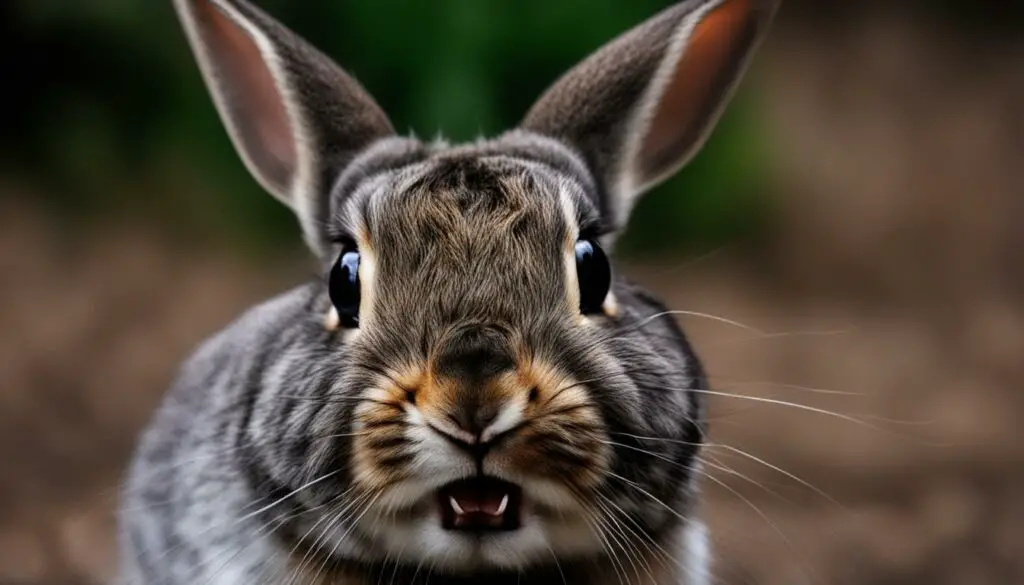
Conclusion
Rabbits are delicate creatures that can easily become stressed. Teeth chattering is a common indicator of stress in rabbits, signaling their anxiety or fear. By knowing the signs of stressed rabbits, identifying the causes of stress, and implementing strategies to manage it, we can create a supportive and nurturing environment for our furry friends.
Remember, each rabbit is unique, so it’s important to observe their behavior and tailor your approach accordingly. Building a strong bond with your rabbit and providing them with the care and attention they need will go a long way in ensuring their happiness and well-being.
Different Chattering Styles in Rabbits and Their Meanings
When it comes to rabbit communication, understanding the various chattering styles can provide valuable insights into your furry friend’s emotions and needs. Rabbits have different ways of chattering, and each style carries its own meaning. By paying attention to factors such as volume, body language, activity level, rhythm, triggers, and duration of chattering episodes, you can gain a deeper understanding of your rabbit’s state of mind.
One style of chattering is rapid and intense, accompanied by a tense body posture. This type of chattering is often a sign of fear or agitation. It indicates that your rabbit is feeling threatened or uncomfortable in their environment. It’s essential to identify the source of their distress and provide reassurance and a safe space for them to calm down.
Another style of chattering is more rhythmic and accompanied by relaxed body language. This type of chattering typically occurs when a rabbit is content and relaxed. It can be a sign of happiness, satisfaction, or enjoyment. When your rabbit is chattering in this manner, it’s an indication that they are feeling at ease and comfortable in their surroundings.
Understanding your rabbit’s unique chattering style is fundamental to interpreting their emotions and meeting their needs. By observing their chattering patterns and considering the context in which it occurs, you can create a nurturing environment that supports their well-being.
| Chattering Style | Meaning |
|---|---|
| Rapid and intense | Fear or agitation |
| Rhythmic and relaxed | Happiness and contentment |
Remember, each rabbit is unique, and their chattering style may vary. Some rabbits may exhibit a combination of styles or display different styles in different situations. Paying close attention to your rabbit’s chattering and accompanying body language will help you better understand their needs, emotions, and overall well-being.
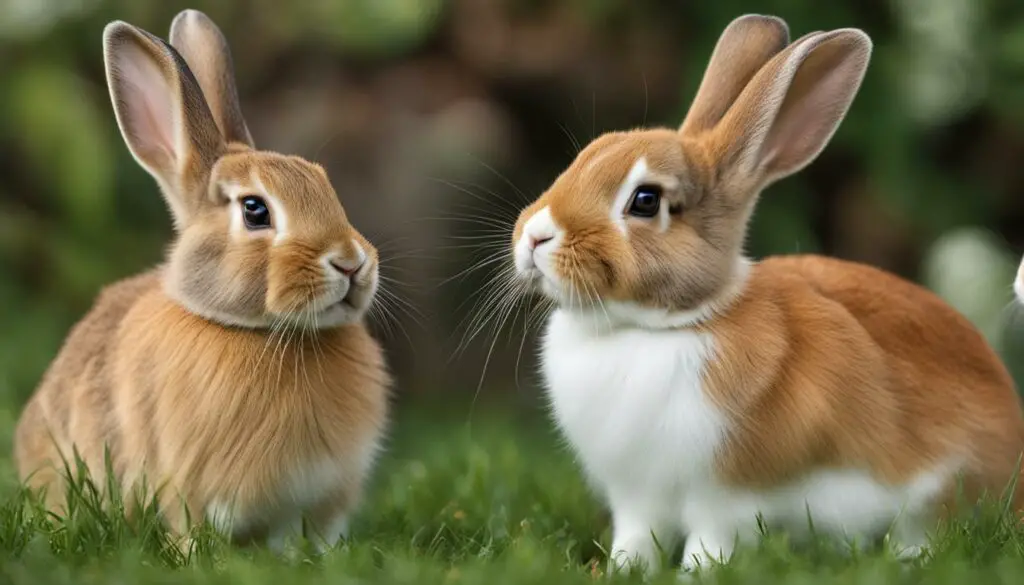
By fostering a strong bond with your rabbit and providing a supportive environment, you can ensure that they feel safe, loved, and understood. Regular interaction, gentle handling, and consistent routines can help reduce stress and anxiety in rabbits, leading to more harmonious chattering styles and a happier, healthier bunny. The key is to be attentive, patient, and responsive to your rabbit’s unique vocalizations and body language cues.
Helping Your Rabbit Cope with Stress and Anxiety
Managing rabbit stress and anxiety is crucial for promoting their overall well-being. Rabbits are sensitive animals that can easily become stressed in certain situations. By creating a comfortable environment and establishing a strong bond with your rabbit, you can help reduce their stress levels and ensure their happiness.
Bonding with your rabbit is an essential step in managing their stress and anxiety. Spending quality time with them, gently handling them, and providing consistent routines can help build trust and strengthen your relationship. This will make your rabbit feel secure and less vulnerable to stressors.
Another important aspect of managing rabbit stress is creating a calm and supportive environment. Minimizing loud noises, providing hiding spots, and maintaining a consistent living space can help reduce stress triggers for your rabbit. Additionally, introducing new experiences gradually and positively can help them adjust better and feel more at ease.
| Ways to Reduce Rabbit Stress and Anxiety | Benefits |
|---|---|
| Provide a quiet and secure living space | Helps rabbits feel safe and decreases anxiety |
| Establish a consistent routine | Reduces uncertainty and promotes a sense of security |
| Provide hiding spots and safe spaces | Gives rabbits a sense of control and security |
| Introduce new experiences gradually | Allows rabbits to adjust at their own pace and reduces stress |
| Offer social interaction and gentle handling | Strengthens the bond with your rabbit and promotes trust |
| Use positive reinforcement techniques | Encourages desired behaviors and reduces stress |
Understanding your rabbit’s body language is also crucial for managing their stress. By learning to interpret their cues and responding appropriately, you can help alleviate their anxiety. For example, if you notice signs of fear or discomfort, such as flattened ears, hunched posture, or rapid breathing, it is important to give them space and avoid any actions that may further stress them.
In conclusion, managing rabbit stress and anxiety is essential for their well-being. By bonding with your rabbit, creating a calm environment, and understanding their body language, you can provide the support and care they need to live a happy and stress-free life.

Conclusion
Rabbits may not make as much noise as other pets, but they do have their own unique way of communicating through sounds. From purring and teeth chattering to growling and whimpering, each sound carries its own meaning and can provide valuable insights into your rabbit’s emotional state and needs. By paying attention to these sounds, observing accompanying body language, and creating a supportive and nurturing environment, you can strengthen your bond with your pet bunny and ensure their overall well-being.
Understanding the range of rabbit sounds and their meanings allows you to better interpret your rabbit’s needs and emotions. Whether it’s the joyful honking, the comforting purr, or the distressing teeth grinding, each sound tells a story and can guide you in providing the appropriate care and attention.
Creating a calm and secure environment for your rabbit, minimizing stressors, and building a strong bond through gentle handling and positive reinforcement are essential in promoting their well-being. By being attuned to their communication cues, you can offer the support and care your rabbit needs to thrive.
Remember, rabbits have their own language, and by learning to understand and respond to their unique sounds, you can build a deeper connection with your furry friend. So listen closely, observe their body language, and create a loving environment to ensure your rabbit’s happiness and overall health.
FAQ
Do bunnies purr?
Yes, rabbits can purr. Purring in rabbits is often associated with contentment and relaxation. It is a sign of happiness and trust.
What are some of the sounds that rabbits make?
Rabbits can make a variety of sounds, including honking, humming, tooth purring, teeth grinding, growling, grunting, whimpering, and hissing.
What does honking, humming, and tooth purring mean in rabbits?
Honking is a sound of excitement or happiness in rabbits. Humming signifies contentment, and tooth purring expresses happiness and relaxation.
Why do rabbits grind their teeth and growl?
Teeth grinding and growling in rabbits usually indicate pain, discomfort, or fear. Teeth grinding can be a sign of dental issues or general pain, while growling is a response to fear or aggression.
What do grunting and whimpering mean in rabbits?
Grunting is a sound that rabbits make when they are mildly annoyed, uncomfortable, or uncertain. Whimpering is a cry that indicates pain, stress, or a need for attention.
Why do rabbits hiss?
Hissing is a hostile sound that rabbits use to signal anger, irritation, or overstimulation. It is a response to perceived threats or uncomfortable situations.
Is teeth chattering while sleeping normal in rabbits?
Yes, teeth chattering or clicking while sleeping is usually harmless and a normal part of a rabbit’s sleep cycle. It does not indicate any discomfort or pain.
What does purring and teeth chattering indicate in rabbits?
Purring in rabbits is a sign of contentment, while teeth chattering can also indicate contentment but may also be a sign of pain, discomfort, or distress depending on the context.
Can teeth chattering in rabbits be a sign of pain or distress?
Yes, persistent, loud teeth chattering in rabbits, accompanied by other symptoms such as loss of appetite, lethargy, or unusual behavior, may indicate pain, discomfort, or distress. It is important to seek veterinary attention in such cases.
What causes stress-induced teeth chattering in rabbits?
Stress-induced teeth chattering in rabbits can be triggered by changes in their environment, the introduction of new pets or rabbits, and loud or unfamiliar noises. Minimizing stressors and providing a calm and secure environment can help reduce teeth chattering in rabbits.
What do different chattering styles indicate in rabbits?
Different chattering styles in rabbits can provide insights into their needs and emotions. Factors such as volume, body language, activity level, rhythm, triggers, and duration of chattering episodes can help interpret a rabbit’s state of mind.
How can I help my rabbit cope with stress and anxiety?
Providing a calm and supportive environment, social interaction, spending quality time together, and gradually introducing new experiences can help your rabbit cope with stress and anxiety. Building a strong bond through gentle handling, consistent routines, and positive reinforcement can also reduce stress and promote their overall well-being.

